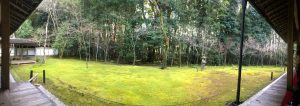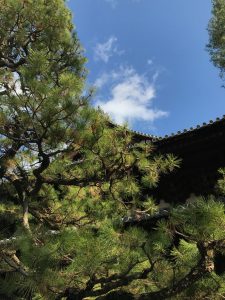Being a part of the Kyoto Artisans course and spending time in Kyoto was the best possible way to spend my Winter Study this year. I have learned so much during this time, both on an academic level and a personal level. At the same time, I think I have built various relationships that I will treasure for the rest of my life.

The first day in Kyoto, when we visited Daitoku-ji, I had never felt so informed and immersed in my own personal culture, and reconnected to Japan. It was a strong, and even emotional, experience — one that continued throughout my time in Kyoto. Being in such an ancient, and former capital, city that is filled with history, culture, and arts is refreshing, reorienting, and educational. I feel like a much better person and much more aware of my surroundings. Beginning and ending the trip with aspects of Zen Buddhism was an incredible way to frame this trip with perspective.
One of my favorite experiences of the trip is still going to Juko-in from that first day. From the beautiful garden to the quiet tea rooms, I felt truly connected to the tea ceremony I so deeply love practicing when I go back home to Hawai‘i. And since it is rarely ever open to the public, I feel like it was almost serendipitous!
One the second day, meeting Mr. Miyamoto was certainly a treat. All the people we visited were truly so talented, and see them work was quite amazing. I loved hearing Mr. Miyamoto talk about his work, and trying to translate the spirit behind his words into English was a true challenge that I enjoyed! The passion and knowledge he and Mr. Yamamoto have for their work deeply inspires me to find something to do with my life that I have such passion for as well. Mr. Yamamoto is the opposite of pretentious — and he is the only person in the world who knows how to make makkyo! I admire his modesty and love for his work. I especially loved that he had such detailed knowledge of the history and place of sacred mirrors throughout time and culture. He is a true craftsman.
Of course, tea ceremony with Dairiku Amae was another incredible experience. He made me think more deeply about what tea ceremony is about. Despite his avant-garde style, he was actually quite easy to understand and a lovely person with whom to talk. I hope to see his work as he becomes older!
Mr. Tatsumura’s textile work was perhaps the one institution we visited, and yet it did not appear to lead on as an institution as we might imagine it. Rather, it was steeped in holding true to the original spirit of the work, while finding new ways to keep the industry of textiles alive. I truly admire his, like all the artisans, dedication to their work. Similarly, Noh Theater with Mr. Udaka was truly an experience. My favorite moment was watching him transition so smoothly to and from acting — as if it were nothing. Yet there must be such tremendous skill involved in moving so gracefully from one mindset to another!
If anything, I come away from this trip with a deeper respect for the artisans in Kyoto. They inspire me to work harder at my own passions and urge me to appreciate my own culture and heritage. At the same time, I do wish we saw some non-male artisans and discussed the struggle of existing in such a male-dominated industry and culture.
Overall, I think the friendships with the other people on the trip made everything so unique and special. The conversations and resulting insights were some of my favorite moments from the trip. I especially appreciate seeing everyone back on campus! However, I think the relationship that strengthened the most during my time in Kyoto is my relationship with my own genealogical roots and my desire to learn more and more about my own cultural background. As I drift farther and farther from the physical location of Japan, I feel myself also drifting away from Japan in multiple ways and this profoundly saddens me. During this trip I found a few different ways to reconnect and strengthen my own relationship to Japan, and as a result, this is perhaps one of the most special trips I will take in my life.

